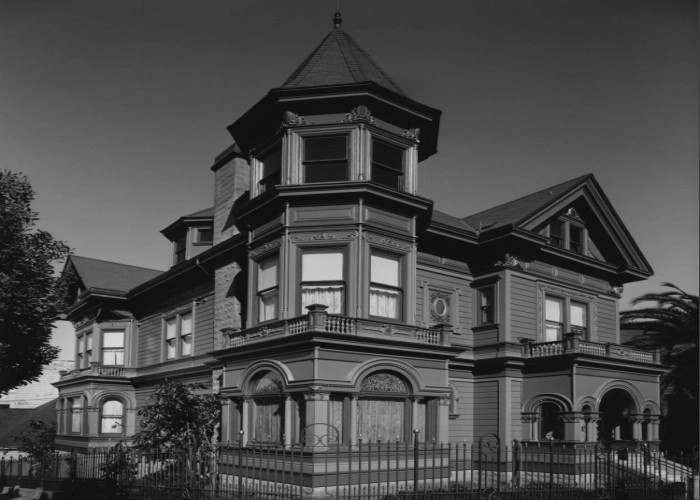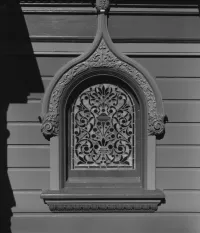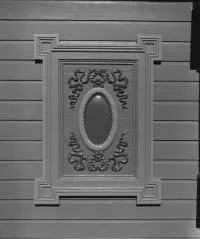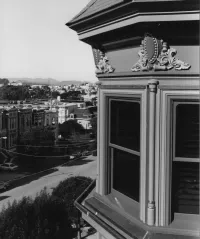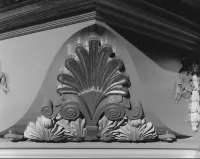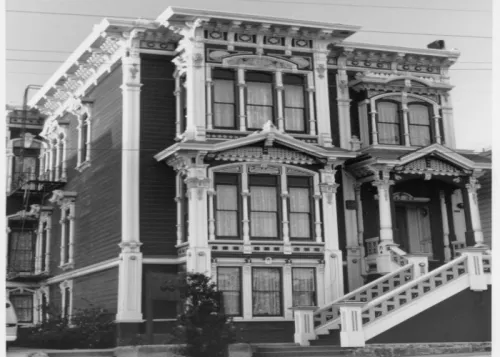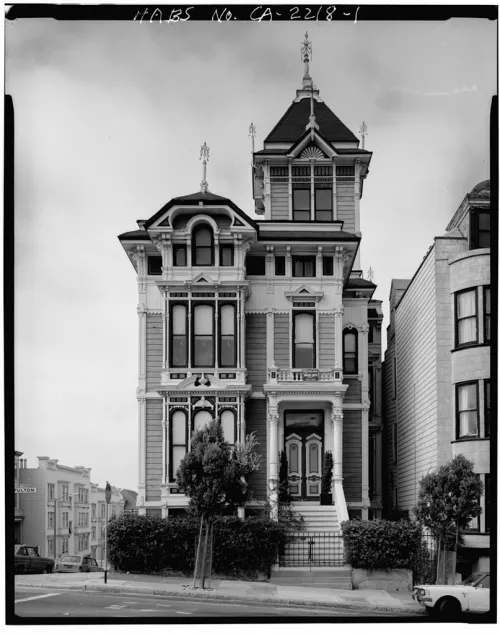Share what you know,
and discover more.
Share what you know,
and discover more.
Apr 14, 2005

-

- Charmaine Bantugan
John Spencer House (Bayview Opera House) - National Register of Historic Places
Statement of Significance The John Spencer house has survived 109 years of the vicissitudes of earthquakes, weather, and neglect with the great majority of its historic fabric intact. This is due in large part to the diligence of its architect, the builder, and the minute attention to detail of all the anonymous artisans and carpenters who contributed to the both the structural integrity and the artistic harmony of the house. It represents a serendipitous combination of first-rate design, sound engineering, great dexterity in construction, and use of the highest quality materials. Also key to its preservation is the fact that it has remained a single-family dwelling for most of its history and has thus escaped the butchery to which so many San Francisco Victorian dwellings were subjected during the rush to provide more housing in the mid-twentieth century. A broad cross section of the major decorative arts of the period survives in stunning condition, both interior and exterior. The conjunction of inexpensive skilled labor, steam-powered milling shops, and a seemingly inexhaustible supply of old growth Douglas fir and Redwood, made houses such as this accessible to upper middle-class merchants like the Spencer family. In addition to a massive body of handwork, early methods of mass production, although cumbersome by today’s standards, are well represented in products used in its construction. Perhaps most striking is the enormous body of wood carvings that adorn both interior and exterior. In an age when so much of the architectural ornament was cast of plaster, this must have represented a considerable additional cost to the owner. It was, however, a wise investment. In 2001, when this author supervised the painstaking restoration of the exterior, he found this legacy of artisanry fresh and intact beneath the myriad layers of paint that had long since obscured the finer details. Although the San Francisco building department was destroyed in the fire that followed in the wake of the 1906 earthquake, it is possible to date construction of the Spencer house to 1895. Construction most likely began in June of that year. The California Architectural and Building News of May 1895 lists: “to build: Owner, John C. Spencer; architect, F. P. Rabin; contractor, Wm. Tegeler; signed April 20'''; filed May 6'*'; cost $6815.” The building cost was almost surely given as artificially low to reduce the cost of the permit. City water records confirm that water was turned on at the site on April 16''’ of 1895. By 1897, the San Francisco city guide lists John Spencer, owner of The Wonder Hat, Flower and Feather Store, as residing at what was then 1040 Haight Street. Spencer, and Irish immigrant, is to be found in San Francisco as far back as 1877, pursuing what was to become a sizeable millinery business. The Spencers sold the house in 1908, and moved to a perhaps more desirable Pacific Heights address. The property was purchased in 1908 by James Costello, president of O’Cormer and Moffit, which was later to become Macy’s department store. Eleanor Costello, wife of James passed away in the house in 1951. It subsequently sat empty for a period of some three years. From 1954 to the present, it has passed through the ownership of 5 different parties. From the 1950’s through the early 1980’s the house went through a period of extended neglect. In the mid 1980’s the house was purchased by the Chambers family. Its interior was lovingly restored over a period of 15 years during which it was run as a bed and breakfast. In 2001, its facade was stripped, restored and repainted. All roofing and sheet metal was replaced. The house was brought back to its original appearance with respect to missing ornaments. Currently the house is undergoing modernization of its electrical, plumbing and heating systems without compromising historic finishes. The house represents 19th century carpentry at its best. So many San Francisco mansions rest on foundations of brick, and after years of seismic activity are sagging and in need of retrofitting. The Spencer house rests upon 13-inch-thick concrete foundation walls encompassing a full basement. In some places the footers are four feet or more below the grade of the slab floor making the walls at least 12 feet tall before backfilling. It is a massive foundation for a residential structure. The platform framing resting upon this foundation is impressive in both the dimension of the lumber as well as the accuracy with which it was executed. The full dimension, 3x12 floor joists, 30 feet or more in length are continuous across the span of the house. Attesting to the quality of the structural design, the house shows almost no signs of settling or sagging after more than a century. On the exterior, great care was taken to protect the structure from moisture penetration. Correct lap and drip edges are present on all exterior woodwork. The joinery is impeccable. Various water tables shed moisture from the structure at regular intervals. The massive redwood gutters were well designed to drain the 4700 square feet of roof Only its original balustrades and certain woodwork on the south and west sides of the house fell prey to neglect and weather. The roof framing is complex and innovative with an interesting use of huge scissor trusses to maintain the enormous open attic. This attic is reputed to have been used as a tennis court by the children of the original owners. The house is notable for its bold ornamentation. As it is freestanding and occupies three city lots, it is trimmed and adorned on all four sides - a relative rarity in San Francisco. It is festooned with an impressive array of cartouches, most of them quite massive, carved in redwood. Many of them are stretched around comers, thus giving an interesting variation to an ornament most often found on flat surfaces. Fanciful variations of acanthus foliage, banded laurel, shells, and other forms of classical ornament are present on every level of the house. In all, there are hundreds of individual carvings, both interior and exterior. Of these, only a handful on the exterior has been replaced with architectural castings made from originals too damaged to be saved. Even the egg-and-dart moldings which adorn the bay windows and portico of the first story are carved. The art of wood tuming is well represented in the copious collection of colonnettes, round pilasters, balusters, and columns that abound inside and out. A testament to the productivity of the steam-powered milling shops of the day, well over three miles of moldings make their way around the exterior in the form of bands, water tables, panel moldings, casings, and dentils. Again, the vast majority are original and represent a varied cross section of profiles in use during the day. The eight, large, stained-glass windows are still present. They are of generous proportion and elaborate design, incorporating Celtic knot patterns and large, three-dimensional prisms, all in autumn tones, which reflect the color of the golden oak woodwork of the interior. Five of the eight were beginning to sag due to the weight of the prisms. These five have been disassembled and re-leaded and braced and now occupy their places as if new. All of the original glass was maintained. The impressive joinery of the interior remains intact and unaltered by anything but time. Quarter sawn oak abounds in coffered ceilings, casings, columns, original furnishings, wainscot and scores of carvings. The first-floor parquet changes its complex motifs from room to room and is made of contrasting, cabinet grade woods. Original plaster medallions are still in place on the ceilings, as are ornate fretwork screens, pocket doors and some of the original light fixtures. Some fixtures were sold in the early eighties, but were subsequently replaced with appropriate antiques. In all, both inside and out, the house is a fine example of the elements of Queen Anne architecture in all its magnificence and caprice. The joy of craft is evident to both the eye, and the intellect. Order and ornament rule the structure and nothing seems out of place. It is evident that many artisans and tradesmen have loved this house and imbued it with the charms necessary to endure.
John Spencer House (Bayview Opera House) - National Register of Historic Places
Statement of Significance The John Spencer house has survived 109 years of the vicissitudes of earthquakes, weather, and neglect with the great majority of its historic fabric intact. This is due in large part to the diligence of its architect, the builder, and the minute attention to detail of all the anonymous artisans and carpenters who contributed to the both the structural integrity and the artistic harmony of the house. It represents a serendipitous combination of first-rate design, sound engineering, great dexterity in construction, and use of the highest quality materials. Also key to its preservation is the fact that it has remained a single-family dwelling for most of its history and has thus escaped the butchery to which so many San Francisco Victorian dwellings were subjected during the rush to provide more housing in the mid-twentieth century. A broad cross section of the major decorative arts of the period survives in stunning condition, both interior and exterior. The conjunction of inexpensive skilled labor, steam-powered milling shops, and a seemingly inexhaustible supply of old growth Douglas fir and Redwood, made houses such as this accessible to upper middle-class merchants like the Spencer family. In addition to a massive body of handwork, early methods of mass production, although cumbersome by today’s standards, are well represented in products used in its construction. Perhaps most striking is the enormous body of wood carvings that adorn both interior and exterior. In an age when so much of the architectural ornament was cast of plaster, this must have represented a considerable additional cost to the owner. It was, however, a wise investment. In 2001, when this author supervised the painstaking restoration of the exterior, he found this legacy of artisanry fresh and intact beneath the myriad layers of paint that had long since obscured the finer details. Although the San Francisco building department was destroyed in the fire that followed in the wake of the 1906 earthquake, it is possible to date construction of the Spencer house to 1895. Construction most likely began in June of that year. The California Architectural and Building News of May 1895 lists: “to build: Owner, John C. Spencer; architect, F. P. Rabin; contractor, Wm. Tegeler; signed April 20'''; filed May 6'*'; cost $6815.” The building cost was almost surely given as artificially low to reduce the cost of the permit. City water records confirm that water was turned on at the site on April 16''’ of 1895. By 1897, the San Francisco city guide lists John Spencer, owner of The Wonder Hat, Flower and Feather Store, as residing at what was then 1040 Haight Street. Spencer, and Irish immigrant, is to be found in San Francisco as far back as 1877, pursuing what was to become a sizeable millinery business. The Spencers sold the house in 1908, and moved to a perhaps more desirable Pacific Heights address. The property was purchased in 1908 by James Costello, president of O’Cormer and Moffit, which was later to become Macy’s department store. Eleanor Costello, wife of James passed away in the house in 1951. It subsequently sat empty for a period of some three years. From 1954 to the present, it has passed through the ownership of 5 different parties. From the 1950’s through the early 1980’s the house went through a period of extended neglect. In the mid 1980’s the house was purchased by the Chambers family. Its interior was lovingly restored over a period of 15 years during which it was run as a bed and breakfast. In 2001, its facade was stripped, restored and repainted. All roofing and sheet metal was replaced. The house was brought back to its original appearance with respect to missing ornaments. Currently the house is undergoing modernization of its electrical, plumbing and heating systems without compromising historic finishes. The house represents 19th century carpentry at its best. So many San Francisco mansions rest on foundations of brick, and after years of seismic activity are sagging and in need of retrofitting. The Spencer house rests upon 13-inch-thick concrete foundation walls encompassing a full basement. In some places the footers are four feet or more below the grade of the slab floor making the walls at least 12 feet tall before backfilling. It is a massive foundation for a residential structure. The platform framing resting upon this foundation is impressive in both the dimension of the lumber as well as the accuracy with which it was executed. The full dimension, 3x12 floor joists, 30 feet or more in length are continuous across the span of the house. Attesting to the quality of the structural design, the house shows almost no signs of settling or sagging after more than a century. On the exterior, great care was taken to protect the structure from moisture penetration. Correct lap and drip edges are present on all exterior woodwork. The joinery is impeccable. Various water tables shed moisture from the structure at regular intervals. The massive redwood gutters were well designed to drain the 4700 square feet of roof Only its original balustrades and certain woodwork on the south and west sides of the house fell prey to neglect and weather. The roof framing is complex and innovative with an interesting use of huge scissor trusses to maintain the enormous open attic. This attic is reputed to have been used as a tennis court by the children of the original owners. The house is notable for its bold ornamentation. As it is freestanding and occupies three city lots, it is trimmed and adorned on all four sides - a relative rarity in San Francisco. It is festooned with an impressive array of cartouches, most of them quite massive, carved in redwood. Many of them are stretched around comers, thus giving an interesting variation to an ornament most often found on flat surfaces. Fanciful variations of acanthus foliage, banded laurel, shells, and other forms of classical ornament are present on every level of the house. In all, there are hundreds of individual carvings, both interior and exterior. Of these, only a handful on the exterior has been replaced with architectural castings made from originals too damaged to be saved. Even the egg-and-dart moldings which adorn the bay windows and portico of the first story are carved. The art of wood tuming is well represented in the copious collection of colonnettes, round pilasters, balusters, and columns that abound inside and out. A testament to the productivity of the steam-powered milling shops of the day, well over three miles of moldings make their way around the exterior in the form of bands, water tables, panel moldings, casings, and dentils. Again, the vast majority are original and represent a varied cross section of profiles in use during the day. The eight, large, stained-glass windows are still present. They are of generous proportion and elaborate design, incorporating Celtic knot patterns and large, three-dimensional prisms, all in autumn tones, which reflect the color of the golden oak woodwork of the interior. Five of the eight were beginning to sag due to the weight of the prisms. These five have been disassembled and re-leaded and braced and now occupy their places as if new. All of the original glass was maintained. The impressive joinery of the interior remains intact and unaltered by anything but time. Quarter sawn oak abounds in coffered ceilings, casings, columns, original furnishings, wainscot and scores of carvings. The first-floor parquet changes its complex motifs from room to room and is made of contrasting, cabinet grade woods. Original plaster medallions are still in place on the ceilings, as are ornate fretwork screens, pocket doors and some of the original light fixtures. Some fixtures were sold in the early eighties, but were subsequently replaced with appropriate antiques. In all, both inside and out, the house is a fine example of the elements of Queen Anne architecture in all its magnificence and caprice. The joy of craft is evident to both the eye, and the intellect. Order and ornament rule the structure and nothing seems out of place. It is evident that many artisans and tradesmen have loved this house and imbued it with the charms necessary to endure.
Apr 14, 2005
John Spencer House (Bayview Opera House) - National Register of Historic Places
Statement of SignificanceThe John Spencer house has survived 109 years of the vicissitudes of earthquakes, weather, and neglect with the great majority of its historic fabric intact. This is due in large part to the diligence of its architect, the builder, and the minute attention to detail of all the anonymous artisans and carpenters who contributed to the both the structural integrity and the artistic harmony of the house. It represents a serendipitous combination of first-rate design, sound engineering, great dexterity in construction, and use of the highest quality materials. Also key to its preservation is the fact that it has remained a single-family dwelling for most of its history and has thus escaped the butchery to which so many San Francisco Victorian dwellings were subjected during the rush to provide more housing in the mid-twentieth century. A broad cross section of the major decorative arts of the period survives in stunning condition, both interior and exterior. The conjunction of inexpensive skilled labor, steam-powered milling shops, and a seemingly inexhaustible supply of old growth Douglas fir and Redwood, made houses such as this accessible to upper middle-class merchants like the Spencer family. In addition to a massive body of handwork, early methods of mass production, although cumbersome by today’s standards, are well represented in products used in its construction. Perhaps most striking is the enormous body of wood carvings that adorn both interior and exterior. In an age when so much of the architectural ornament was cast of plaster, this must have represented a considerable additional cost to the owner. It was, however, a wise investment. In 2001, when this author supervised the painstaking restoration of the exterior, he found this legacy of artisanry fresh and intact beneath the myriad layers of paint that had long since obscured the finer details.
Although the San Francisco building department was destroyed in the fire that followed in the wake of the 1906 earthquake, it is possible to date construction of the Spencer house to 1895. Construction most likely began in June of that year. The California Architectural and Building News of May 1895 lists: “to build: Owner, John C. Spencer; architect, F. P. Rabin; contractor, Wm. Tegeler; signed April 20'''; filed May 6'*'; cost $6815.” The building cost was almost surely given as artificially low to reduce the cost of the permit. City water records confirm that water was turned on at the site on April 16''’ of 1895. By 1897, the San Francisco city guide lists John Spencer, owner of The Wonder Hat, Flower and Feather Store, as residing at what was then 1040 Haight Street. Spencer, and Irish immigrant, is to be found in San Francisco as far back as 1877, pursuing what was to become a sizeable millinery business. The Spencers sold the house in 1908, and moved to a perhaps more desirable Pacific Heights address. The property was purchased in 1908 by James Costello, president of O’Cormer and Moffit, which was later to become Macy’s department store. Eleanor Costello, wife of James passed away in the house in 1951. It subsequently sat empty for a period of some three years. From 1954 to the present, it has passed through the ownership of 5 different parties. From the 1950’s through the early 1980’s the house went through a period of extended neglect. In the mid 1980’s the house was purchased by the Chambers family. Its interior was lovingly restored over a period of 15 years during which it was run as a bed and breakfast. In 2001, its facade was stripped, restored and repainted. All roofing and sheet metal was replaced. The house was brought back to its original appearance with respect to missing ornaments. Currently the house is undergoing modernization of its electrical, plumbing and heating systems without compromising historic finishes.
The house represents 19th century carpentry at its best. So many San Francisco mansions rest on foundations of brick, and after years of seismic activity are sagging and in need of retrofitting. The Spencer house rests upon 13-inch-thick concrete foundation walls encompassing a full basement. In some places the footers are four feet or more below the grade of the slab floor making the walls at least 12 feet tall before backfilling. It is a massive foundation for a residential structure. The platform framing resting upon this foundation is impressive in both the dimension of the lumber as well as the accuracy with which it was executed. The full dimension, 3x12 floor joists, 30 feet or more in length are continuous across the span of the house. Attesting to the quality of the structural design, the house shows almost no signs of settling or sagging after more than a century. On the exterior, great care was taken to protect the structure from moisture penetration. Correct lap and drip edges are present on all exterior woodwork. The joinery is impeccable. Various water tables shed moisture from the structure at regular intervals. The massive redwood gutters were well designed to drain the 4700 square feet of roof Only its original balustrades and certain woodwork on the south and west sides of the house fell prey to neglect and weather. The roof framing is complex and innovative with an interesting use of huge scissor trusses to maintain the enormous open attic. This attic is reputed to have been used as a tennis court by the children of the original owners.
The house is notable for its bold ornamentation. As it is freestanding and occupies three city lots, it is trimmed and adorned on all four sides - a relative rarity in San Francisco. It is festooned with an impressive array of cartouches, most of them quite massive, carved in redwood. Many of them are stretched around comers, thus giving an interesting variation to an ornament most often found on flat surfaces. Fanciful variations of acanthus foliage, banded laurel, shells, and other forms of classical ornament are present on every level of the house. In all, there are hundreds of individual carvings, both interior and exterior. Of these, only a handful on the exterior has been replaced with architectural castings made from originals too damaged to be saved. Even the egg-and-dart moldings which adorn the bay windows and portico of the first story are carved. The art of wood tuming is well represented in the copious collection of colonnettes, round pilasters, balusters, and columns that abound inside and out. A testament to the productivity of the steam-powered milling shops of the day, well over three miles of moldings make their way around the exterior in the form of bands, water tables, panel moldings, casings, and dentils. Again, the vast majority are original and represent a varied cross section of profiles in use during the day. The eight, large, stained-glass windows are still present. They are of generous proportion and elaborate design, incorporating Celtic knot patterns and large, three-dimensional prisms, all in autumn tones, which reflect the color of the golden oak woodwork of the interior. Five of the eight were beginning to sag due to the weight of the prisms. These five have been disassembled and re-leaded and braced and now occupy their places as if new. All of the original glass was maintained. The impressive joinery of the interior remains intact and unaltered by anything but time. Quarter sawn oak abounds in coffered ceilings, casings, columns, original furnishings, wainscot and scores of carvings. The first-floor parquet changes its complex motifs from room to room and is made of contrasting, cabinet grade woods. Original plaster medallions are still in place on the ceilings, as are ornate fretwork screens, pocket doors and some of the original light fixtures. Some fixtures were sold in the early eighties, but were subsequently replaced with appropriate antiques.
In all, both inside and out, the house is a fine example of the elements of Queen Anne architecture in all its magnificence and caprice. The joy of craft is evident to both the eye, and the intellect. Order and ornament rule the structure and nothing seems out of place. It is evident that many artisans and tradesmen have loved this house and imbued it with the charms necessary to endure.
Posted Date
Apr 12, 2022
Historical Record Date
Apr 14, 2005
Source Name
United States Department of Interior - National Park Service
Source Website
Delete Story
Are you sure you want to delete this story?
